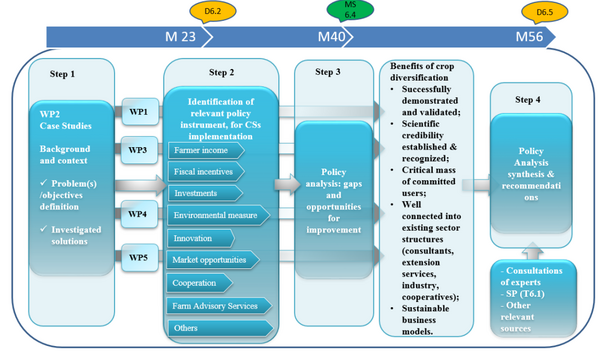Public policies play an important role in decision-making by farmers and other actors regarding the sustainability of crop production. In fact, unlike many other sectors, agriculture is one in which direct public intervention remains the norm rather than the exception. This makes farming activity particularly sensitive to changes in public policy. Farmers’ decisions are heavily influenced by market support, direct payments, agri-environmental policy and environmental legislation. These decisions may be further shaped by water, energy or planning policies.
Within the DiverIMPACTS project, a framework for policy analysis has been developed and will be applied to the DiverIMPACTS case studies. From this analysis, we aim to obtain general policy lessons as well as case study-specific recommendations to promote crop diversification. The application of the framework implements different data sources. Some of the data are obtained from published sources (e.g. legislation, reports, official statistics), while other information (mainly at the national/local level) requires specific actors to be consulted. This consultation will take the form of interviews and questionnaires, in cooperation with the work taking place by the case studies. Figure 1 illustrates the main steps of the DiverIMPACTS policy analysis framework. The framework includes 4 procedural steps:
- Step 1: Case study background and context. This step aims to identify the main problems underlying the emergence of the case study and the solutions investigated to overcome these problems;
- Step 2: identify and describe existing key policy instruments that link directly to the DiverIMPACTS case studies. These instruments will be analysed to determine whether they have potential to promote crop diversification strategies, as well as to identify the contribution and potential of crop diversification to wider EU agro-environmental objectives;
- Step 3: The analysis carried out in the previous step will allow DiverIMPACTS to identify any gaps in current policies and find areas for improvement and opportunities to overcome these gaps;
- Step 4: Based on the results of the previous activity, recommendations for tailored policy instruments to support crop diversification will be developed. These recommendations will also take into account information from an extensive literature review, expert consultation and internal knowledge of the DiverIMPACTS consortium, as well as the scientific evidence of the benefits of crop diversification. Furthermore, policy recommendations will address the value chain (contract arrangements, added value chain, market development, labelling and certification for sustainable agricultural practices, etc.).
It should be noted that the DiverIMPACTS project is running across two CAP programmes (CAP 2014-2020 and CAP beyond 2020). The analysis carried out so far explores how current policies may provide incentives to promote crop diversification.
In addition, DiverIMPACTS is working together with the other projects in the Crop Diversification Cluster (Diverfarming, DIVERSify, LegValue, ReMIX and TRUE) to provide joint policy recommendations to make the sociotechnical systems more disposed to crop diversification.

 tap and then scroll down to the Add to Home Screen command.
tap and then scroll down to the Add to Home Screen command.